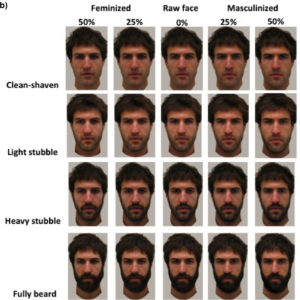I’m working on my third Whitford Crew book and came to a place where I had to go back and count how many days it had been since my hero had an opportunity to shave. That led to an image search for “three day stubble” and then next thing I knew, I had a dozen tabs open for research about beards and facial hair attractiveness ratings. So I might as well share my findings, right?
Most of the research on attractiveness of male facial hair comes from one Australian researcher: Dr. Barnaby James Wyld Dixson at the School of Psychology of the University of Queensland. His faculty photo, of course, shows him wearing a beard of his own. You can hear him discussing his research on a 2013 interview with the Psychology of Attractiveness Podcast. (When asked about his facial hair, he says that he used to be clean-shaven but grew a beard while traveling and got used to having it, a change approved of by his partner.)
The only research on this topic I’d heard before was that men with beards are perceived as better potential fathers [1], but that really only scratches the surface of the research questions Dixson and his colleagues have looked into.
Most attractive facial hair? Stubble.
 The largest study is “The masculinity paradox: facial masculinity and beardedness interact to determine women’s ratings of men’s facial attractiveness,” published in the Journal of Evolutionary Biology in 2016 [2]. In this research, 8520 women were shown digitally manipulated photos of male faces varying in facial hair from clean‐shaven, light stubble, heavy stubble and full beards to appear more (+25% and +50%) or less (−25% and −50%) masculine. Results showed that “[m]asculine faces were judged as least attractive, followed by feminized faces, with unmanipulated faces rated most attractive…beards may mask the unattractive features of having overly feminine or masculine face shapes.” As for the level of facial hair, “stubble was judged as most attractive overall and received higher ratings for short‐term relationships than full beards, which were more attractive for long than short‐term relationships.” This and several other studies mentioned that beards may be seen as signals for a man’s age and masculine social dominance.
The largest study is “The masculinity paradox: facial masculinity and beardedness interact to determine women’s ratings of men’s facial attractiveness,” published in the Journal of Evolutionary Biology in 2016 [2]. In this research, 8520 women were shown digitally manipulated photos of male faces varying in facial hair from clean‐shaven, light stubble, heavy stubble and full beards to appear more (+25% and +50%) or less (−25% and −50%) masculine. Results showed that “[m]asculine faces were judged as least attractive, followed by feminized faces, with unmanipulated faces rated most attractive…beards may mask the unattractive features of having overly feminine or masculine face shapes.” As for the level of facial hair, “stubble was judged as most attractive overall and received higher ratings for short‐term relationships than full beards, which were more attractive for long than short‐term relationships.” This and several other studies mentioned that beards may be seen as signals for a man’s age and masculine social dominance.
If stubble is better than a full beard, does the shape of facial hair have any bearing? Male grooming website Prim & Prep ran a survey of 300 presumably American women through SurveyMonkey to learn that among women 18-44, short stubble is the most attractive facial hair, followed by clean shaven. The “circle beard” combo of mustache and goatee ranked lowest, with full beard ranked in the middle of the pack.
Variables affecting beard preferences
Does the time of her menstrual cycle affect how attractive a woman finds facial hair? A 2018 study with a sample of 52 heterosexual women said no [3]. “Results showed an overall preference for bearded over clean-shaven faces at each phase of the menstrual cycle. However, preferences for facial hair were not significantly different over the phases of menstrual cycle and were not significantly associated with levels of reproductive hormones. We conclude that women’s preferences for men’s beardedness may not be related to changes in their likelihood of conception.”
However, men with beards may look healthier and more attractive to women with concerns about pathogens, according to a 2020 multivariate analysis of 919 American women shown images of 37 “ethnically Northern European men.” [4] This research also found that women who rated images of ticks and lice on hair as more disgusting had a preference for images of clean-shaven men, which 2019 research [5] looked at whether there was a correspondence between a country’s parasite levels and its women’s preferences for chest hair and found no correlation. Women who are older and like beards, however, also tend to like chest hair.
Another of the variables the 2020 multivariate study [4] reviewed was whether the women wanted to have children. In that case, women who wanted kids generally found beards more attractive–but single women who wanted kids rated clean-shaven male faces highly while married women who wanted children rated clean-shaven faces negatively. One more finding from this study: no correspondence was found between whether a woman’s father was bearded and her adult preferences regarding men with beards.
Most of this research centers on the preferences of heterosexual women, but I did find one 2017 study including homosexual men [6]. “Based on an online survey of 1577 participants from Brazil and the Czech Republic, we found that, on average, homosexual men preferred hairier stimuli than heterosexual women, supporting past findings that homosexual men have strong preferences for masculine traits. Preferences for facial and body hair appear to be influenced less by sex of the preferred partner than sex of the individual, pointing to a possible sex-specific mating psychology.”
Historical beard preferences
For the historical romance crowd (and I know I kinda buried the lede), this one is interesting: “Mustache Fashion Covaries with a Good Marriage Market for Women” is a 2001 review of British beards through time [7]. Full text is not free, alas, but here’s the abstract:
It was predicted that men would emphasize sexually-selected traits, including mustaches, beards, and sideburns, when they have difficulty obtaining spouses. Using annual data on British beard fashions extending from 1842–1971, it was found that mustaches, and facial hair in general, are more frequent when there is a good supply of single men of marriageable age. Facial hair fashions, particularly mustaches and beards, were reduced when illegitimacy ratios were high. Regression analyses showed that the relationship between mustache fashion and the marriage market and illegitimacy, respectively, is independent of linear time trend. Results suggest that facial hair is worn to enhance a man’s marriage prospects by increasing physical attractiveness and perception of social status. Men shave their mustaches, possibly to convey an impression of trustworthiness, when the marriage market is weak and women might fear sexual exploitation and desertion.
Final beard science facts
Two final conclusions, not about what women think about men with beards, but indicative of what men with beards think about themselves.
First, 2016 results of an online survey [8] of American and Indian men found that “men with facial hair were significantly higher in hostile sexism than clean-shaven men; hostile sexism was a significant predictor of facial hair status over and above demographic variables; and facial hair was more frequent among ambivalent and hostile sexists than among benevolent and non-sexists. It is suggested that sexist men choose to grow facial hair because it maximizes sexual dimorphism and augments perceived masculinity and dominance.”
Second, and perhaps most disappointing for your bearded man seeking to augment his dominance, a 2018 review of records from the Ultimate Fighting Championship [9] found “no evidence that beardedness was associated with fewer losses by knock-out or greater fighter ability” in a paper titled “Contest competition and men’s facial hair: beards may not provide advantages in combat.”
References
1 Barnaby J. Dixson, Robert C. Brooks, The role of facial hair in women’s perceptions of men’s attractiveness, health, masculinity and parenting abilities, Evolution and Human Behavior, Volume 34, Issue 3, 2013, Pages 236-241, ISSN 1090-5138, https://doi.org/10.1016/j.evolhumbehav.2013.02.003
2 Dixson, B.J.W., Sulikowski, D., Gouda‐Vossos, A., Rantala, M.J. and Brooks, R.C. (2016), The masculinity paradox: facial masculinity and beardedness interact to determine women’s ratings of men’s facial attractiveness. J. Evol. Biol., 29: 2311-2320. doi:10.1111/jeb.12958
3 Barnaby J.W. Dixson, Anthony J. Lee, Khandis R. Blake, Grazyna Jasienska, Urszula M. Marcinkowska, Women’s preferences for men’s beards show no relation to their ovarian cycle phase and sex hormone levels, Hormones and Behavior, Volume 97, 2018, Pages 137-144, ISSN 0018-506X, https://doi.org/10.1016/j.yhbeh.2017.11.006
4 Clarkson Tessa R., Sidari Morgan J., Sains Rosanna, Alexander Meredith, Harrison Melissa, Mefodeva Valeriya, Pearson Samuel, Lee Anthony J. and Dixson Barnaby J. W. 2020 A multivariate analysis of women’s mating strategies and sexual selection on men’s facial morphology R. Soc. open sci. 7191209 https://royalsocietypublishing.org/doi/10.1098/rsos.191209#
5 Dixson, B.J.W., Rantala, M.J. & Brooks, R.C. Cross-Cultural Variation in women’s Preferences for men’s Body Hair. Adaptive Human Behavior and Physiology 5, 131–147 (2019). https://doi.org/10.1007/s40750-019-0107-x
6 Jaroslava Varella Valentova, Marco Antonio Corrêa Varella, Klára Bártová, Zuzana Štěrbová, Barnaby James Wyld Dixson, Mate preferences and choices for facial and body hair in heterosexual women and homosexual men: influence of sex, population, homogamy, and imprinting-like effect, Evolution and Human Behavior, Volume 38, Issue 2, 2017, Pages 241-248, ISSN 1090-5138, https://doi.org/10.1016/j.evolhumbehav.2016.10.007
7 Barber, N. Mustache Fashion Covaries with a Good Marriage Market for Women. Journal of Nonverbal Behavior 25, 261–272 (2001). https://doi.org/10.1023/A:1012515505895
8 Oldmeadow, J.A., Dixson, B.J. The Association Between Men’s Sexist Attitudes and Facial Hair. Arch Sex Behav 45, 891–899 (2016). https://doi.org/10.1007/s10508-015-0637-7
9 Barnaby J.W. Dixson, James M. Sherlock, William K. Cornwell, Michael M. Kasumovic, Contest competition and men’s facial hair: beards may not provide advantages in combat, Evolution and Human Behavior, Volume 39, Issue 2, 2018, Pages 147-153, ISSN 1090-5138, https://doi.org/10.1016/j.evolhumbehav.2017.11.004


